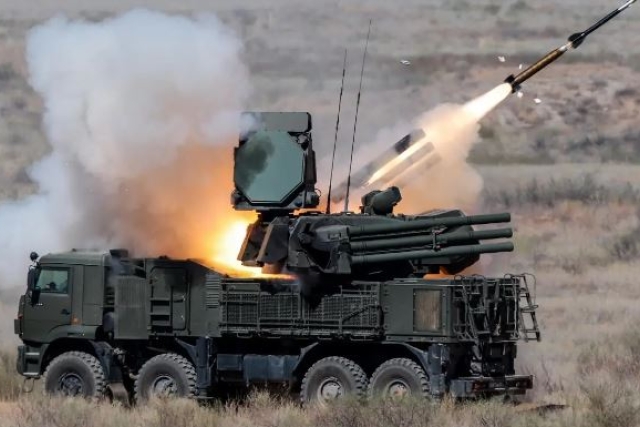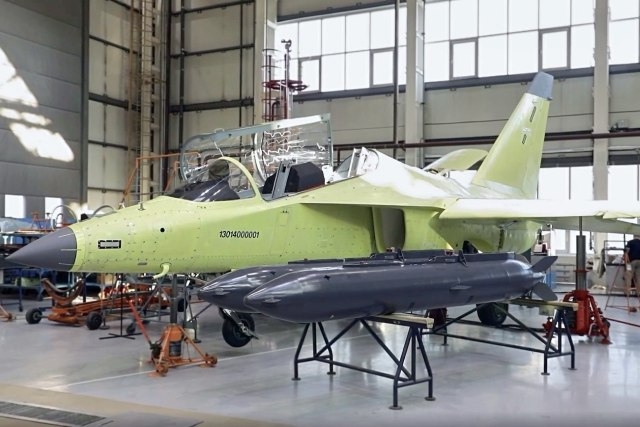Battle of Counter-Drone SAMs- Raytheon's Coyote Vs. Russian Pantsir-S1
Strategies and Innovations in Countering Drone Threats:

Mobile LIDS anti-drone system @Raytheon
The spectacular success of drones on the battlefield in Ukraine has prompted Russia and the United States to develop counter-measures against them.
Russia this week tested a unique upgrade to its Pantsir-S1 air defense system- one that combines an electronic warfare system for a "soft kill" of drones in the air together with a gun-missile system for the "hard kill" approach.
On February 13, Baltic Fleet servicemen underwent a drill to protect command posts from UAV attacks, the Russian MoD announced. "During the drills, a protective dome with a radius of several dozens of kilometers was set up combining the Leer-3 EW system and the Pantsir-S1 gun-missile system."
Earlier, TASS revealed that the Pantsir-S1M was being upgraded to carry 48 mini missiles, up from the 12 standard missiles it currently carries with the specific purpose of combating drone swarms.
The U.S. Army announced on 9 February that it has awarded a contract to Raytheon worth $75 million for the production of 600 Coyote 2C interceptors in support of its counter-unmanned aircraft systems (C-UAS) mission.
Over the years, American company Raytheon's KuRFS radar has evolved from a sense-and-warn radar, initially developed in 2012 for tracking rocket, artillery, and mortar attacks in Afghanistan and Iraq, into a counter-UAS solution.
In parallel, the Coyote interceptor transitioned from a tube-launched UAV to a rail-launched, radar-guided missile positioned as a counter-UAS system. In 2019 the Coyote, now under Raytheon Technologies, was designated as an air defense missile, equipped to intercept drones. The introduction of Coyote Block 2 in 2020 further enhanced its capabilities, allowing it to engage single drones and swarms at higher altitudes and longer ranges than comparable systems.
In 2020, the Low, slow, small, unmanned aircraft Integrated Defeat System (LIDS) program was established, integrating KuRFS and Coyote with other systems to create a multi-mission solution. LIDS, deployable in mobile or fixed platforms, provides a layered defense against the growing threat of unmanned systems, addressing Group 1-3 UAS threats.

The successful testing of Coyote interceptors in 2021, where they destroyed mock enemy drones, further validated the capabilities of the integrated LIDS system.
In April 2023, Raytheon Technologies secured a $237 million contract from the U.S. Army for KuRFS and Coyote effectors. This contract aimed to enhance detection and defeat capabilities against unmanned aircraft (UAVs). LIDS, with its KuRFS precision targeting radar and Coyote interceptors, proved instrumental in providing persistent detection, identification, and tracking of airborne threats. The success of LIDS was again demonstrated in 2023 during tests at the Army’s Yuma Proving Ground, where KuRFS detected a complex swarm, and Coyote interceptors effectively defeated multiple targets, both singles and swarms.
International interest in LIDS is substantial, with more than a dozen countries seeking briefings, and the U.S. State Department approving a potential sale of the system to Qatar. As the Army prepares for its next record test in Arizona, the LIDS system stands poised to showcase its exceptional capabilities and continued effectiveness in countering unmanned aerial threats.
Counter-drone Systems in the Russia-Ukraine War
In the Ukraine War, both Ukraine and Russia employ counter-drone systems against the widespread use of drones. Traditional air defenses, including interceptors and anti-drone guns, prove effective against larger, slower drones, but the cost of intercepting drones remains a challenge.
To address this, electronic warfare tactics such as jammers and high-energy lasers are increasingly used to disrupt drones, especially smaller ones that can swarm and overwhelm air defenses.
Ukraine faces challenges in electronic warfare compared to Russia but receives support from NATO member states, incorporating the latest Counter-Unmanned Aerial Systems (C-UAS) technology. These systems vary, from handheld devices like the Skywiper EDM4S to larger platforms like the Terrahawk Paladin, Slinger, and Cortex Typhoon. Mobile C-UAS platforms, mounted on trucks or armored vehicles, provide flexibility in deployment.
Ukraine also utilizes Smartshooter systems to modify existing weapons for drone targeting. While effective, these systems have limitations in detecting and engaging drones in swarms.

Additionally, Ukraine deploys the Brave 1 counter-drone system, emitting "white noise" to interfere with drone radio frequencies. This system can disable drones from a distance, employing passive detection to evade countermeasures and suppressing satellite navigation data transmissions.
In November 2023, Ukraine conducted trials on drones from six private companies to assess their resilience against electronic warfare (EW) interference. The Ministry of Defense specifically evaluated FPV drones designed by private enterprises to withstand complex EW radiation. The assessments included testing resistance to signal suppression in video communication and control channels. Notably, one manufacturer showcased a serially developed kamikaze drone, demonstrating stability in video communication and control functions when faced with electronic warfare systems. Ukraine has deployed an electronic warfare system capable of disabling unmanned aerial systems through radio interference.
Russia employs electronic warfare units to counter Ukrainian drone strikes, occasionally disabling mobile internet to interfere with drone communication. To achieve this, mobile internet is being disabled in certain regions, including Leningrad, Novgorod, and Pskov in northwestern Russia, between January 25-30, according to Russian media.The decision to switch off 4G networks at night is attributed to the need to facilitate anti-drone operations, as both LTE wireless broadband and electronic warfare units operate on the same frequencies.
As the conflict evolves, the need for cost-effective, compact, and portable defense systems against UAS threats becomes apparent. Electronic warfare continues to play a crucial role, with both sides adapting their strategies in response to emerging technologies and tactics.









